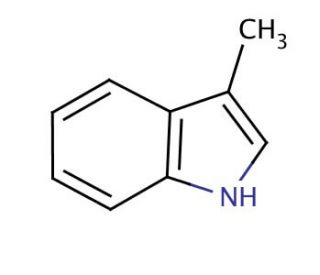

Molecular structure of 3-Methylindole, CAS Number: 83-34-1
3-Methylindole (CAS 83-34-1)
See product citations (1)
Alternate Names:
Skatole
Application:
3-Methylindole is a naturally abundant pneumotoxin
CAS Number:
83-34-1
Purity:
99%
Molecular Weight:
131.17
Molecular Formula:
C9H9N
Supplemental Information:
This is classified as a Dangerous Good for transport and may be subject to additional shipping charges.
For Research Use Only. Not Intended for Diagnostic or Therapeutic Use.
* Refer to Certificate of Analysis for lot specific data.
QUICK LINKS
Ordering Information
Product Citations
Description
Technical Information
Safety Information
SDS & Certificate of Analysis
3-Methylindole serves as a potent odorant in various experimental applications. It acts as a ligand for specific olfactory receptors. This interaction leads to the activation of downstream pathways, ultimately resulting in the perception of a distinct odor. At the molecular level, 3-Methylindole interacts with the olfactory receptors on the surface of sensory neurons, initiating a series of biochemical reactions that culminate in the transmission of olfactory signals to the brain. 3-Methylindole′s mechanism of action involves its ability to bind to and activate specific receptors, thereby eliciting a sensory response.
3-Methylindole (CAS 83-34-1) References
- Selective dehydrogenation/oxygenation of 3-methylindole by cytochrome p450 enzymes. | Lanza, DL. and Yost, GS. 2001. Drug Metab Dispos. 29: 950-3. PMID: 11408359
- 3-Methylindole-induced splenotoxicity: biochemical mechanisms of cytotoxicity. | Updyke, LW., et al. 1991. Toxicol Appl Pharmacol. 109: 375-90. PMID: 1853340
- 3-Methylindole production is regulated in Clostridium scatologenes ATCC 25775. | Doerner, KC., et al. 2009. Lett Appl Microbiol. 48: 125-32. PMID: 19055631
- Fe(III) stimulates 3-methylindole and 4-methylphenol production in swine lagoon enrichments and Clostridium scatologenes ATCC 25775. | Doerner, KC., et al. 2009. Lett Appl Microbiol. 48: 118-24. PMID: 19055633
- 3-Methylindole metabolites induce lung CYP1A1 and CYP2F1 enzymes by AhR and non-AhR mechanisms, respectively. | Weems, JM. and Yost, GS. 2010. Chem Res Toxicol. 23: 696-704. PMID: 20187624
- Aerobic biotransformation of 3-methylindole to ring cleavage products by Cupriavidus sp. strain KK10. | Fukuoka, K., et al. 2015. Biodegradation. 26: 359-73. PMID: 26126873
- Phase I metabolism of 3-methylindole, an environmental pollutant, by hepatic microsomes from carp (Cyprinus carpio) and rainbow trout (Oncorhynchus mykiss). | Zlabek, V., et al. 2016. Chemosphere. 150: 304-310. PMID: 26915592
- Skatole (3-Methylindole) Is a Partial Aryl Hydrocarbon Receptor Agonist and Induces CYP1A1/2 and CYP1B1 Expression in Primary Human Hepatocytes. | Rasmussen, MK., et al. 2016. PLoS One. 11: e0154629. PMID: 27138278
- Characterization of 3-Methylindole as a Source of a 'Mud'-like Off-Odor in Strong-Aroma Types of Base Baijiu. | Dong, W., et al. 2018. J Agric Food Chem. 66: 12765-12772. PMID: 30392373
- Isolation and characterization of two Acinetobacter species able to degrade 3-methylindole. | Tesso, TA., et al. 2019. PLoS One. 14: e0211275. PMID: 30689668
- Dysregulation of murine immune functions on inhalational exposure to ammonia, dimethyl disulfide, 3-methylindole, or propionic acid. | Kim, H., et al. 2021. Toxicol Ind Health. 37: 219-228. PMID: 33663293
- Regeneration of olfactory neuroepithelium in 3-methylindole-induced anosmic rats treated with intranasal chitosan. | Li, ST., et al. 2021. Biomaterials. 271: 120738. PMID: 33711565
- Effect of 3-methylindole on respiratory ethane production in selenium and vitamin E deficient rats. | Kiorpes, AL., et al. 1988. Biochem Biophys Res Commun. 153: 535-9. PMID: 3382386
- Toxicity of 3-methylindole, 1-nitronaphthalene and paraquat in precision-cut rat lung slices. | Price, RJ., et al. 1995. Arch Toxicol. 69: 405-9. PMID: 7495379
- Metabolism of 3-methylindole by vaccinia-expressed P450 enzymes: correlation of 3-methyleneindolenine formation and protein-binding. | Thornton-Manning, J., et al. 1996. J Pharmacol Exp Ther. 276: 21-9. PMID: 8558432
Ordering Information
| Product Name | Catalog # | UNIT | Price | Qty | FAVORITES | |
3-Methylindole, 5 g | sc-256535 | 5 g | $41.00 | |||
3-Methylindole, 25 g | sc-256535A | 25 g | $104.00 |
